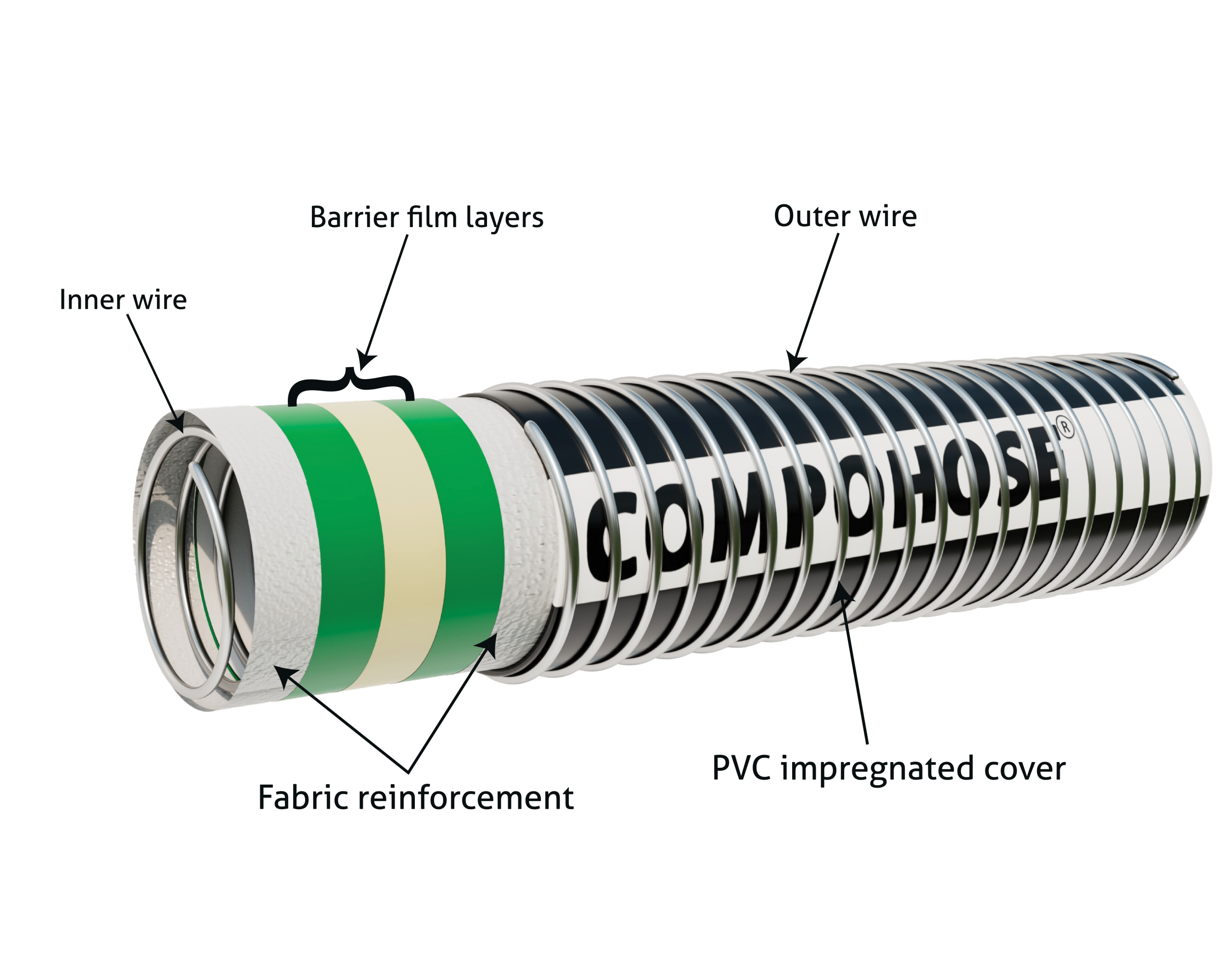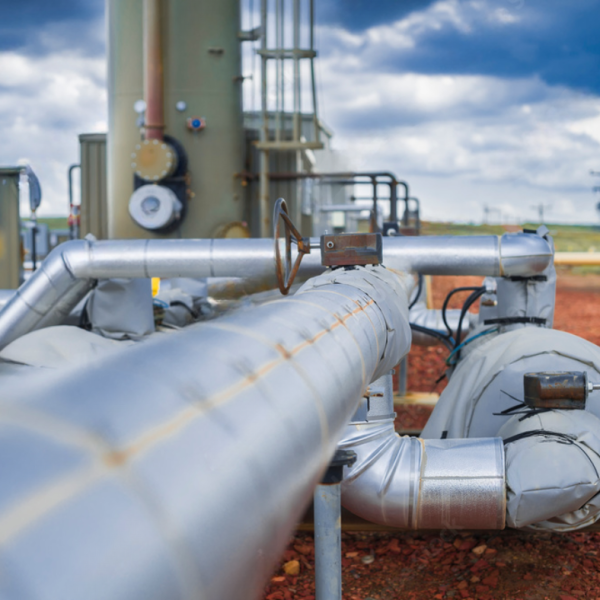Frack Hose

Hydraulic fracturing, commonly known as fracking, is a process that involves creating fractures or fissures within shale formations to release trapped natural gas. This is achieved by pumping sand, water, and other additives into the rock formations. The FRACK HOSE is specifically designed as a safe handling hose for this process. It boasts high flexibility, ensuring effective and efficient manoeuvrability, even in sub-zero temperatures. The hose is lightweight and flexible in both very low and very high temperatures, making it ideal for seamless connections and disconnections throughout the day.
Compliance : Frack hoses are manufactured in accordance to EN 13765 / 2018 Type 3


Construction
- Hose Type - SPG, PPS, SPS
- Inner wire - Galvanised Steel/ Polypropylene Coated Galvanised Steel/Stainless Steel 304, 316
- Inner Lining -Multiple layers of Polypropylene fabric, film and polyester barrier layers
- Outer wire -Galvanised Steel/Stainless Steel 304, 316
- Cover - Abrasion-resistant PVC impregnated fabric
- End fitting -As per client requirements, externally crimped and swaged
Features
- Tough PVC outer cover resists dragging, wearing, abrasion, UV and ozone resistance ensures maximum durability and safety.
- Light Weight & Highly Flexible
- Superior Electrical Continuity
- Specially compounded Polypropylene fabric, film and polyester barrier layers.
- Suitable for 0.9 Bar Vacuum rating.
- Working Pressure: 14 Bar (200 PSI)
- Safety factor 4:1 as per EN 13765 / 2018 (can be achieved higher if required)
- Temperature Range for this hose is -30° C to +100° C (-22° F to +212° F)
Applications
Fluid Transportation: Composite hoses are used to transport fluids like water, chemicals, and hydraulic fracturing fluids between various components of the fracking operation, such as from storage tanks to injection wells or from mixing tanks to the wellhead.
Chemical Injection: Various chemicals are injected into the well during fracking, including corrosion inhibitors, scale inhibitors, biocides, and gelling agents. Composite hoses are used to deliver these chemicals from storage tanks to the injection points.
Water Supply: Hydraulic fracturing requires a significant amount of water. Composite hoses can be used to transfer water from water sources like ponds, rivers, or water storage tanks to the wellsite for mixing with chemicals and proppants.
Flowback Operations: Once hydraulic fracturing is complete, flowback operations involve recovering the fracturing fluids and produced water. Composite hoses can be utilized to transport these fluids for treatment or disposal.
Flexible Connections: The nature of fracking operations involves a dynamic environment with high pressures and varying conditions. Composite hoses offer flexibility and durability, allowing for safe and efficient fluid transportation while accommodating movement and pressure changes.
Specification Table :
| CODE | SIZE | MEAN OD | MAX W.P | MIN BURST | BEND RADIUS | WEIGHT (KG) | MAX LENGTH | |||||||
| NAME | MM | INCH | MM | BAR | PSI | BAR | PSI | MM | INCH | GG & SG | MT | FT | ||
| F02GG25 | 25 | 1” | 37 | 14 | 200 | 56 | 800 | 200 | 8 | 1.00 | 30 | 100 | ||
| F02GG38 | 38 | 1.5” | 51 | 14 | 200 | 56 | 800 | 200 | 8 | 1.35 | 30 | 100 | ||
| F02GG50 | 50 | 2” | 65 | 14 | 200 | 56 | 800 | 225 | 9 | 1.50 | 30 | 100 | ||
| F02GG65 | 65 | 2.5” | 77 | 14 | 200 | 56 | 800 | 225 | 9 | 2.10 | 30 | 100 | ||
| F02GG75 | 75 | 3” | 90 | 14 | 200 | 56 | 800 | 350 | 14 | 3.00 | 30 | 100 | ||
| F02GG100 | 100 | 4” | 121 | 14 | 200 | 56 | 800 | 400 | 16 | 5.60 | 30 | 100 | ||
| F02GG150 | 150 | 6” | 179 | 14 | 200 | 56 | 800 | 575 | 23 | 11.00 | 30 | 100 | ||
| F02GG200 | 200 | 8” | 233 | 14 | 200 | 56 | 800 | 800 | 32 | 16.40 | 30 | 100 | ||
| F02GG250 | 250 | 10” | 284 | 14 | 200 | 56 | 800 | 1000 | 40 | 21.30 | 15 | 50 | ||
| F02GG300 | 300 | 12” | 333 | 14 | 200 | 56 | 800 | 1200 | 48 | 26.70 | 15 | 50 | ||
*Higher burst pressure can be achieved on special request
Safety Standards
Rigorous Safety Testing
COMPOHOSE assemblies undergo comprehensive testing, conducted at 1.5 times the rated Working Pressure (W.P). This stringent testing adheres to the EN 13765 standard, ensuring a paramount level of safety and reliability.
Provision of Manufacturer's Test Certificate
With each supply of COMPOHOSE composite hose assemblies, a Manufacturer's Test Certificate is included. This certificate serves as a confirmation of the product's quality and compliance with safety standards, providing added assurance to users.
Clear Burst Pressure Specification
The burst pressure of the composite hose is explicitly indicated for ambient temperature conditions. This vital information enhances safety awareness and empowers users to operate within secure pressure limits.
Effective Electrical Continuity
The composite hose's electrical continuity is assured through the integration of two bonded wires connected to the end fitting. This innovative design promotes the dissipation of accumulated electrical charges, mitigating the risk of static flashes and associated hazards.



